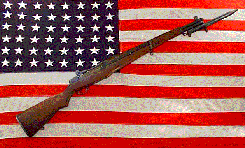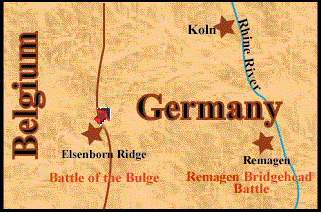[Home]| [Childhood]|[Battle of the Bulge]| [Northeast to Koln]|[Remagen Bridgehead Battle]|[Bridgehead Expansion]|[Ruhr Battle]|

The Remagen Bridgehead Battle

In
early March, the 394th bypassed Koln and fought battles at Bergheim, Elsdorf,
and Fortuna in the Erft Canal area. They were northwest of Koln when ordered to
turn immediately south towards the city of Remagen. Both German and Allied
forces had already bombed many of the bridges that crossed the Rhine but
amazingly, the railroad bridge at Remagen still stood. Upon hearing this,
American forces raced to cross this bridge that would take them deep into enemy
territory. Meanwhile, the Germans were desperate to blow the bridge and prevent
the American penetration.
Built in
1916, Remagen's railroad bridge rested on four fortress-like towers black with
grime. The overall length was 1,069 feet. A year before the start of WWII, the
Germans had installed an elaborate demolition scheme to blow up the bridge in
the face of an enemy attack. Now, as German troops crossed the bridge, they
warned of the Americans coming behind them. Although Hitler gave prior orders
to destroy any bridge threatened by the enemy, he was fanatically against
destroying a bridge prematurely; therefore, precious time was lost in deciding
when to blow up the bridge.
Finally,
Germans received the order from Major Hans Scheller, staff officer of the
German Army Corps, and raced to set off the explosion. Much to their surprise,
nothing happened. The activation key was turned again and again and still no
response. A repair team moved onto the bridge under intense machine gun, tank
fire, and phosphorus smoke screens that burned the eyes and skin. Unable to
complete the repair job, a German volunteer dashed to the bridge and ignited
the primer cord by hand. At last, a sudden roar ripped through the air and
timbers flew wildly in every direction. Yet, when the smoke cleared, the bridge
still stood!
Despite the
fact that the bridge was structurally damaged, under constant heavy artillery
fire, pitted with huge holes, and littered with dead bodies, the allied troops
poured across.
Remagen Memories--The Race to the
Rhine
|
|
|
Remagen Bridge |
According to
a diary written by a K Company soldier and given to Captain Simmons, K Company
reached the outskirts of Koln but bypassed it and continued to Elsdorf, where
"villages were wrecked and fires were still burning." K Company moved
on to Garsdorf and to Anstel and then to Gohn (northwest of Koln). Suddenly,
they were ordered to turn south to the city of Remagen. They began a dead-heat
race with the Germans to reach the Rhine River and cross the bridge at Remagen.
The soldiers had to discard much equipment, including their blankets, to lessen
the load. It was still uncomfortably cold in early March. Pine branches were
cut down and used for blankets during the one hour of sleep each man received
while his buddy stood watch. Two or three times per night the troops stopped to
"dig in" and then were told to "move out." The partially-dug,
unused fox holes were left behind as they continued the relentless drive to the
Rhine. The lack of food, shelter, and sleep became the enemy. Troops searched
abandoned farm houses for food and usually turned up nothing. To find a piece
of German black bread or home-canned cherries was nirvana--the gift of life
itself. At one point, Pvt. Arlinghaus gagged while eating a jar of fat
drippings just to keep from starving.
Crossing the Bridge
On March 10,
1945, they arrived in the town of Remagen--the Germans were waiting for them. A
deafening Boom! Boom! sounded about 250 feet down the main road. Artillery guns
had opened up in a "traverse and search" military operation. The
shells were exploding at precise intervals killing the troops with deadly
precision. Because of his sergeant's training in Heavy Weapons at Camp Wheeler,
Georgia, Arlinghaus knew the shells hit every ten seconds; this was the time it
took to reload the artillery and change its trajectory (position). His platoon,
with just four or five months of infantry training, was not so lucky;
Arlinghaus yelled to his buddies to "hit the ditch" but many were
dead before they knew what happened. The only way to outwit the gunners was to
dive into a ditch right before a shell exploded, break into a run while
counting to eight, and dive again before the next shell exploded two seconds
later.
Everything
was in chaos. Men screamed and writhed in agony as they watched their blood
stream onto the road. Arlinghaus gave them "wound pills" but felt
helpless to do more. He picked up a soldier who had half his buttock blown off,
carried him up an incline to a brick house and into the cellar for protection.
He put the soldier down in a cleaned-out coal bin and looked around for
something to lay him on. There was nothing. He lit a candle and bandaged the
man who didn't even whimper (probably in shock, he thought). As he turned to
go, the soldier pleaded with him to stay. Arlinghaus felt like hell leaving him
there but knew his duty was to continue fighting with the troops. He placed the
man's rifle, topped with his helmet, at the door to alert the medics. (The
rifle topped with a helmet is the army's pre-arranged signal that a wounded man
is nearby). As he walked out the front door, he could see his thinned out
Company running towards the bridge; behind them was a scene far worse than any
depicted in Dante's Inferno. A line from the Charge of the Light
Brigade echoed in his head: "through the valley of death rode the six
hundred...." As he ran to catch up, he knew he would meet the mutilated
man in his nightmares and wonder if he survived.
When Company
K crossed the Remagen railroad bridge, the night was so black that it seemed
the earth ceased to exist. The blinding flash and deafening scream of artillery
every thirty seconds reminded the men that they remained in hell. The soldiers
were taut with fear, expecting the bridge to collapse. Men who were not shot,
worried about falling through the jeep-sized holes. Some sources say that at
many places the holes in the bridge stretched all the way across, while some
were located between the railroad tracks and between the tracks and the steel
girders. Arlinghaus was terrified because he could not swim. He kept his eyes
on a white track and dutifully followed it, although he did not know why it was
there. Later, he thought the white tape may have been put down for tanks to
follow. He did not know how long it took to cross the bridge. Many thought it
took a lifetime.
